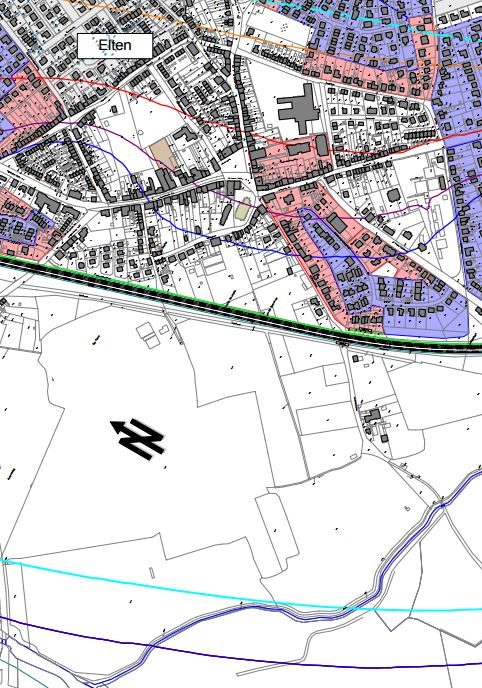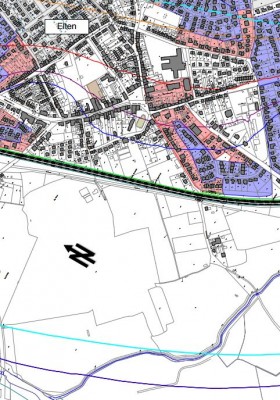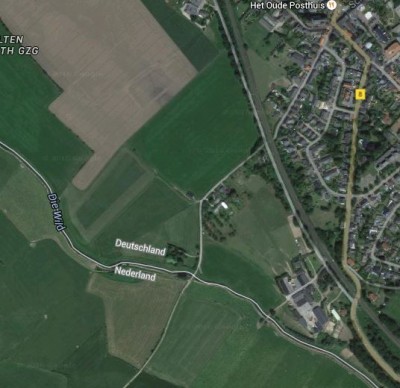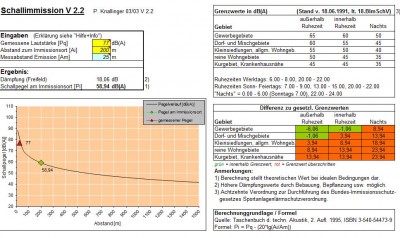I found myself volunteering for a role in the Noisy-committee of the club. We have to abide by the rules, so the first question is ”what are the rules?”
Following is just a collection of bits and pieces, just to get started.
Excel sheet for calcs (download to your pc)
All about audio: audio-stuff
https://www.modellbau-bocholt.de/images/mbg/dokumente/flugplatzordnung_2011.pdf
Paragraph 9: 60 dBa at the nearest house!! Which is rather an important fact. Whivh would translate into 78dB(A) at our site!
https://www.laermorama.ch/m1_akustik/schallpegel_w.html#rechnen
Equipment: anything under 200 Euronen is not worth looking at.. It needs to be a Class 2 certified one.
Laserliner (various prices, from 160-270, so shop around. ) Can be calibrated!! wich is Very Important! Of course those calibrators are not cheap: calibrator. Why you need one (This site has a lot of good ”howto” info.
We also have a very high back ground noise at the field, caused by the Betuwe Lijn. I have measured in excess of 60 dBA when the train passes on a quit afternoon. The houses that we want to ”protect” are much closer to the railway, so they already suffer from much higher noise then whatever we can add. That’s another story!
These guys did a lot of measurements, so use them to our advantage 😉
https://www.umweltbundesamt.de/sites/default/files/medien/461/publikationen/4005.pdf
Our location:
https://www.emmerich.de/c125747b002691ea/files/isophonenkarte_elten.pdf/$file/isophonenkarte_elten.pdf?openelement
https://www.google.nl/maps/@51.8666569,6.1551396,769m/data=!3m1!1e3
Worth mentioning is that the allowed noise level at this location is 59dBA during daylight hours. (in the LautstärkeGleichenkarte Elten above.)
source: https://www.emmerich.de/de/inhalt/drittes-gleis-und-laermschutz/
So, what is the max level that we are theoretically allowed to produce to reach the 59dBA level?? The distance to the houses is 200 meter (centre of field), therefore a max level is 77dBA is theoretically allowable. This is not to say that we should be lower!
Of course, knowing the level does not help you any further if you want to fix_it. Some kind of octave-filter app is almost a must, but most I-phone/Androids have plenty gadgets to held you find the offending frequencies. (Needless to say, it almost always is the prop/exhaust noise that is the cause of the problem.)
Procedure: from https://www.mfc-hameln-lachem.de/flugsicherheit/laermmessung
Die Messungen sind unter folgenden Bedingungen durchzuführen:
- Das Flugmodell ist so zu positionieren, dass sich der im Abschnitt Lärmmesspunkte definierte Bezugspunkt in einer Höhe von 1 m ± 0,1 m über dem Boden befindet und die Flugzeuglängsachse parallel zum Boden verläuft. Das Luftfahrtbundesamt kann in Sonderfällen eine andere Aufstellungsgenehmigen.
- Zur Vermeidung von Reflexionen dürfen in einem Umkreis von 30 m um das Mikrofon sowie um das Flugmodell keine die Messung beeinflussenden Gegenstände vorhanden sein.
- Die Lärmmessung muss auf einem kurzgemähten Grasboden erfolgen.
- Das Flugmodell ist so zu positionieren, dass sich die Flugzeuglängsachse in einem Winkel von 90° ± 30° zur Windrichtung befindet. Die Lärmmessung hat auf der zum Wind abgewandten Seite des Modells zu erfolgen.
- Die Windgeschwindigkeit darf 5m/sec nicht überschreiten.
- Die Messung muss an jedem Punkt über einen Zeitraum von mindestens 30 s erfolgen; maßgebend ist der höchste in diesem Zeitraum gemessene Pegel.
- Die Umgebungstemperatur muss zwischen 10°C und 30° C liegen; keinNiederschlag.
- Das Umgebungsgeräusch muss mindestens 10 dB(A) unter dem vom Modellerzeugten Geräusch liegen.
- Die Messung muss bei Vollgas erfolgen. Eine Limitierung von Leistung und Drehzahl, die zur Erfüllung der Lärmschutzforderungen vorgenommen wird, ist nicht erlaubt.
- Für die Messung muss ein Präzisionsschallpegelmesser nach DIN EN 60651 oder nach DIN EN 60804, in beiden Fällen mindestens Klasse 2, in der Betriebsart „langsam“ („slow“) und im Anzeigemodus „dB(A)“ verwendet werden. Die Kalibrierung der Messanlage mit einem akustischen Schalldrucknormal zur Überprüfung der Empfindlichkeit der Anlage und zur Ermittlung des Bezugspegels darf nicht länger als zwei Jahre zurückliegen.
Auf unserem Gelände gelten folgende Werte:
- Kolbenmotor 82 dB (A) >> in our situation it is 78
- Turbine 90 dB (A)
Also part of the whole thing a flightlog? (automated/RaspberryPi?)
Find a meter with a usb connection to a laptop and use USB extenders. (For safety mostly)
Make a decent test stand




